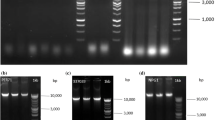Abstract
Isolation and purification of biologically active RNA from filamentous fungi is difficult because of the complex cell wall and the high level of polysaccharides which bind to or co-precipitate with RNA. Using benzyl chloride and guanidine thiocyanate, RNA was successfully isolated from Blakeslea trispora in which other RNA extraction methods and commercially available kits failed to deliver suitable results. The RNA isolated by this procedure appears to be relatively pure, as it has a ratio of absorbance at 260/280 nm of 1.8–1.9. The integrity of the RNA was further substantiated by RT-PCR and Northern hybridization, respectively. This procedure should be useful for isolating RNA from other filamentous fungi and, therefore, will serve as an important tool for the molecular analysis of these organisms.



Similar content being viewed by others
References
Lee, P. C., & Schmidt-Dannert, C. (2002). Applied Microbiology and Biotechnology, 60, 1–11 Medline. DOI 10.1007/s00253-002-1101-x.
Jayaram, R. (1986). Proceedings of the National Academy of Sciences of the United States of America, 83, 7344–7347 Medline. DOI 10.1073/pnas.83.19.7344.
Quiles-Rosillo, M. D., Ruiz-Vazquez, R. M., Torres-Martinez, S., & Garre, V. (2003). FEMS Microbiology Letters, 222, 229–236 Medline.
Mukhtar, M., Parveen, Z., & Logana, D. A. (1998). Journal of Microbiological Methods, 33, 115–118 DOI 10.1016/S0167-7012(98)00047-5.
Yang, H., Wang, S. C., & Wang, Z. T. (2004). Chin. Pharm. J., 39, 254–256.
Li, B., Wang, B., Tang, K., Liang, Y. L., Wang, J., & Wei, J. M. (2006). Colloids and Surfaces B: Biointerfaces, 49, 101–5 DOI 10.1016/j.colsurfb.2006.03.006..
Chomczynski, P., & Sacchi, N. (1987). Analytical Biochemistry, 162, 156–159 Medline. DOI 10.1016/0003-2697(87)90021-2.
Majumdar, D., Avissar, Y. J., & Wyche, J. H. (1991). BioTechniques, 11, 94–101 Medline.
Dessel, W. V., Mellaert, L. V., Geukens, N., Lammertyn, E., & Anne, J. (2004). Journal of Microbiological Methods, 58, 135–137 Medline. DOI 10.1016/j.mimet.2004.03.015.
Keulen, G. V., Siebring, J., Rembacz, K. P., Hoogeveen, M., Tomczynska, , & Dijkhuizen, L. (2004). Journal of Microbiological Methods, 58, 139–142 Medline. DOI 10.1016/j.mimet.2004.03.014.
Lopez-Gomez, R., & Gomez-Lim, M. A. (1992). HortScience, 27, 440–442.
Sharma, A. D., Gill, P. K., & Singh, P. (2003). Analytical Biochemistry, 314, 319–21 Medline. DOI 10.1016/S0003-2697(02)00689-9.
Shan, Z. P., Meng, Y., & Jiang, W. H. (2001). Biotechnology (Chinese), 11, 5–7.
Chirgwin, J. M., Pryzbyla, A. E., & Macdonald, R. J. (1979). Biochemistry, 18, 5294–5299 Medline. DOI 10.1021/bi00591a005.
Raina, K., & Chandlee, J. M. (1996). BioTechniques, 21, 1030–1032 Medline.
Acknowledgements
The authors would like to acknowledge the financial support of the National Natural Science Foundation of China (No. 20376007), the Foundation of Key Laboratory of Bioprocess of Beijing (Grant No. SYS 100100421), the National Natural Science Foundation of China (Grant no. 20576010), the National Natural Science Foundation of China (No. 20776009), and the Program for New Century Excellent Talents (NCET-05-0117).
Author information
Authors and Affiliations
Corresponding author
Additional information
Ye Li and Wenya Wang contributed to the work equally.
Rights and permissions
About this article
Cite this article
Li, Y., Wang, W., Du, X. et al. An Improved RNA Isolation Method for Filamentous Fungus Blakeslea trispora Rich in Polysaccharides. Appl Biochem Biotechnol 160, 322–327 (2010). https://doi.org/10.1007/s12010-008-8289-x
Received:
Accepted:
Published:
Issue Date:
DOI: https://doi.org/10.1007/s12010-008-8289-x




